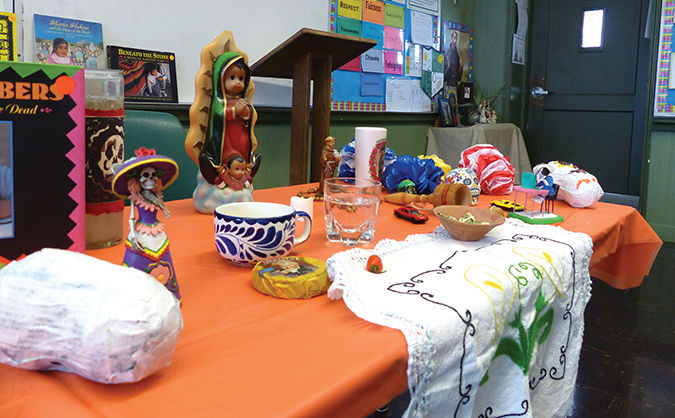For many children residing in East Los Angeles, death could be part of their daily lives.
Death is depicted on street murals in the neighborhood. Death can happen to a next door neighbor who is walking on the street. Death can come to a bellowed family member — "abuelito,” “abuelita,” “tío," “tia.”
These are some of the experiences shared by third graders at Our Lady of Guadalupe School on Hazard Avenue, just a few steps away from Hammel Street, where a Virgin of Guadalupe mural covering a side wall of a mom-and-pop market includes several dancing skeletons.
“Remember that man that died when a palm tree fell on him?” one of the boys says to longtime teacher Florencia Teran, during a lesson about Día de los Muertos (Day of the Dead), a Mexican tradition to honor the deceased during All Souls Day, Nov. 2.
“He was my neighbor,” the boy continues. “And he also was his neighbor,” he added, pointing to a classmate.
The Día de los Muertos has a healing component, Teran told The Tidings. “Just like the students did, people talk openly about death. “It is an important part of our Mexican culture, and it also offers an opportunity to share our cultural traditions with other cultures.”
Teran, of Mexican descent, will head a group of students participating at the Oct. 29 Dia de los Muertos educational/catechetical day at Calvary Cemetery in East Los Angeles, sponsored by the Archdiocese of Los Angeles.
What the Mexican tradition of Día de los Muertos adds is the “bright colors, the hopeful colors of death," said Father Chris Ponnet, head of St. Camillus Center for Spiritual Care, who concelebrates at an annual interfaith funeral service for L.A. County's unclaimed dead.
Those bright colors are shared at Yolanda Munoz’ home in East L.A. Seven years ago the 34-year-old alumna of OLG School started the Día de los Muertos tradition of building altars with a group of about 50 people between family members and neighbors, which last year outgrew to 200 people.
“This is the legacy I will leave to my kids,” said Munoz, mother of three children ages 14, 10 and 7. “The children pray, they learn about what their Grandpa used to like (the altar is built with favorite objects and food of the deceased), all of which takes away the fear of death.”
“It’s very important to talk about death,” added teacher Teran. “Here in the U.S. we fear death, while Mexicans laugh about it in a respectful way.”
The celebration is actually “very cathartic,” said Giovanni Perez, consultant for elementary catechesis at the archdiocesan Office of Religious Education. “It is about playing with death, where death becomes a playmate. It’s a communion with death and so the defenses go down and the scary feelings also go down because it becomes a playful relationship.”
Death is another way to connect people as a human family, wrote Perez in an essay, "It Is in Dying That We Are Born to Eternal Life."
"Although it can be painful and not fully understood, the Church teaches us something beautiful about it. For us, who believe in Jesus, death finds its true meaning in the light of the Paschal Mystery, that is, the death and resurrection of Christ."
Even St. Francis of Assisi acknowledged that close relationship with death when he referred to “her” as “Sister Death,” Perez wrote, because “he understood it as a doorway to eternal peace and joy.”
The Archdiocese of Los Angeles will host its first Día de los Muertos Vigil at Calvary Cemetery, starting Oct. 29 with a catechetical day for Catholic school students. On Nov. 1 festivities open to the public start at 3 p.m. at Calvary’s Main Mausoleum, decorated with altars honoring the dead. A Mass will be celebrated at 5 p.m. in the Main Chapel, followed by a Mariachi concert and social gathering with food and refreshments.
For more information, call the cemetery, (323) 261-3106.

